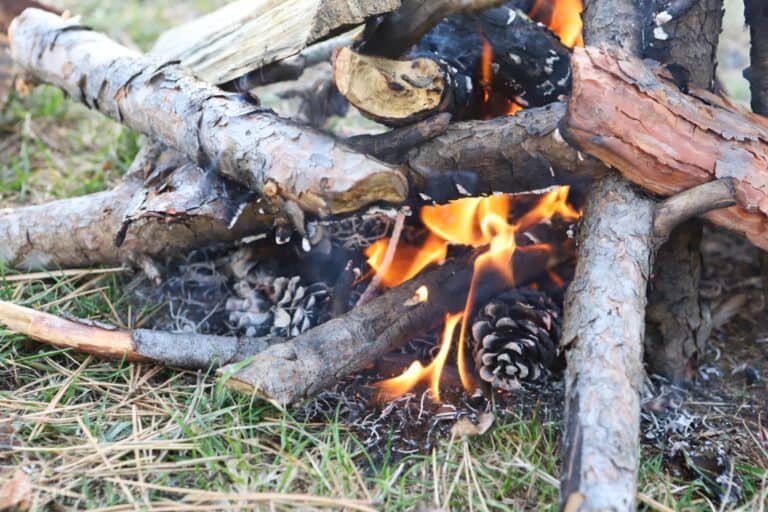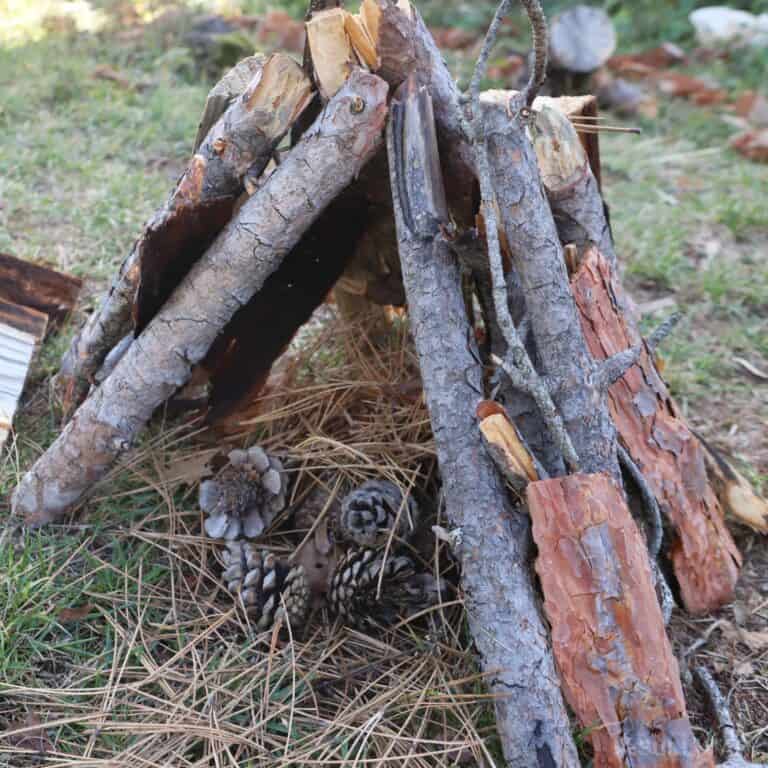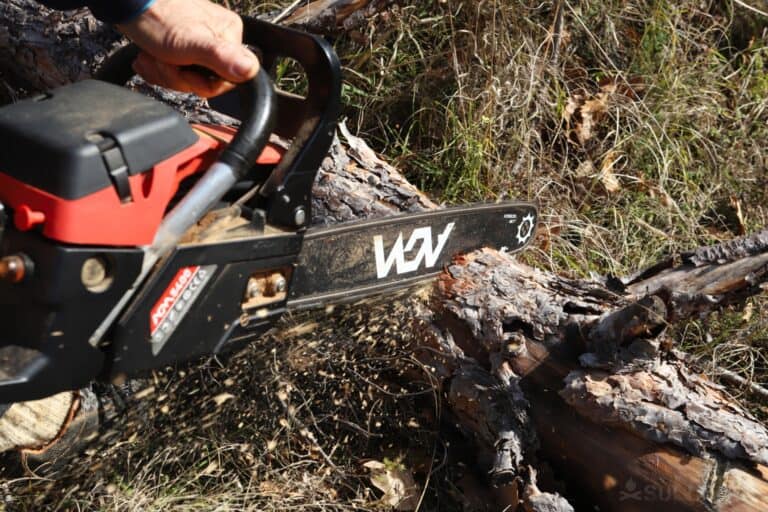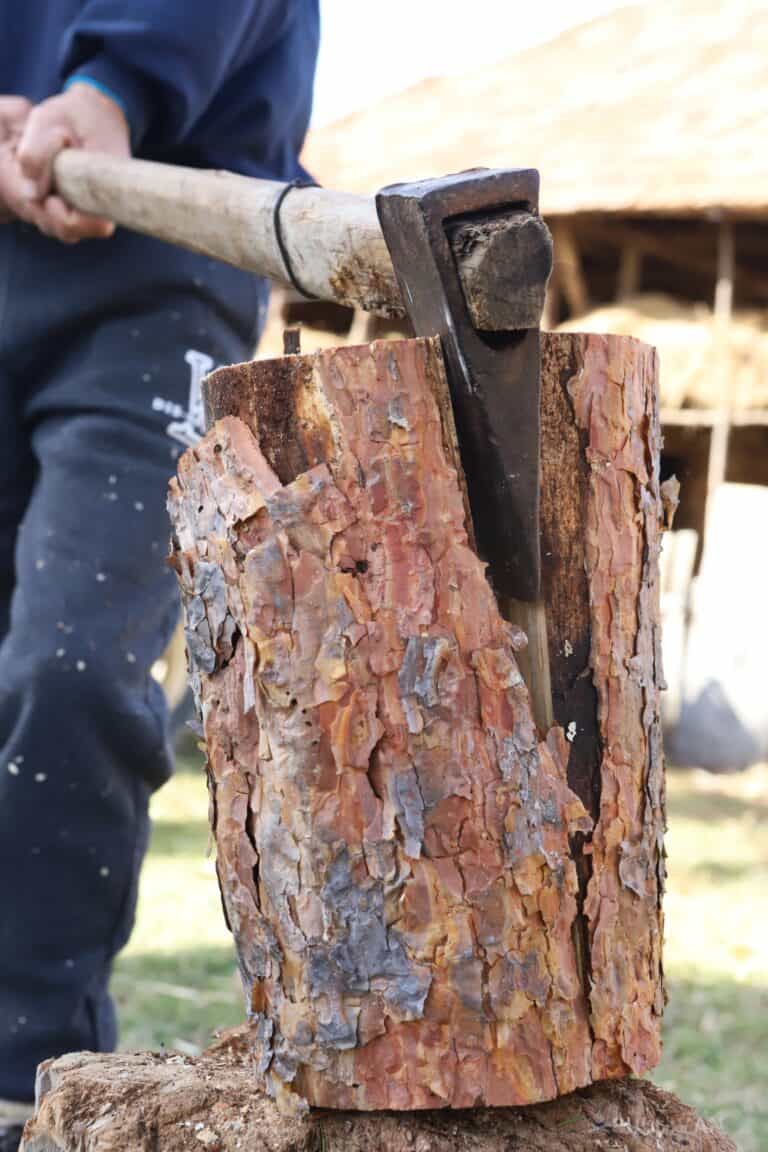Making and tending fires, whether indoors or out, is an essential skill to learn for preppers, or for anyone who lives in colder climates. Building a fire and keeping it roaring bright looks really easy in the movies and on TV, but in reality it is anything but with many variables to account for.

One of the chief variables is what kind of fuel you are burning, and almost all the time when talking about a traditional fire the fuel is wood.
There are all kinds of varieties and species of wood, and each of them behave slightly differently as a fuel, and each have their own pros and cons. You may not have any choice in what wood you are burning, but if you do, wouldn’t it be best to pick the right fuel for the job?
Can you use pine as firewood or not?
Yes you can use it, particularly for kindling. But, it has several shortcomings when used as a primary fuel, namely that it burns very hot with lots of flames.
Pine has a high sap content, which means it will spark and spit more than typical hardwood. This can be a secondary fire hazard inside or out. Sap also leads to significant creosote buildup when burned.
Despite this, pine is absolutely viable and a safe fuel choice when used with caution. But why?
One of the most common softwoods around the world is pine, and its abundance would make it a great choice of fuel if it were not for the many detractors shunning pine as firewood, citing various shortcomings that range from annoying to dangerous. Is there any merit to these complaints?
As with all things, knowing when to use it, when not to use it and what shortcomings you must work to minimize is all that is required to get good use out of any material, including pine as a firewood.
Common Types of Pine Used As Firewood
There are over 100 types of pine tree to choose from with 36 available in North America with similarities in heat generation. Here are some of the most common types of pine firewood you can find in your area.
- Eastern White Pine (Pinus strobus)
- Western White Pine (Pinus monticola)
- Red pine (Pinus resinosa) – Also Norway Pine
- Southern Yellow Pine (Pinus echinata)
- Ponderosa Pine (Pinus ponderosa)
- Sugar Pine (Pinus lambertiana)
- Jack Pine (Pinus banksiana)
- Pitch Pine (Pinus rigida)
All of these types of wood are very easy to burn, even in wet conditions. They produce a moderate heat that lasts for short bursts. All of these species of pine wood will also produce the resin impregnated fatwood that is commonly found within.
Hands On With Pine Firewood
Working with pine trees is relatively light work in terms of splitting it up for firewood. For most logs and trees you can probably get away with a hand saw and a hatchet.
Processing
Since it is a softwood, pine splits easier than other types of firewood. A sharp hatchet will easily cleave through most 12 inch long pieces.
You’ll notice with hardwoods that trying to push a saw through can take some extra effort. With how soft pines are, the saw can bite into the wood and sheer through at a much faster rate.
Resin
The sticky sap within the pine is great as a fire starter but will burn as black as the night while it starts up. This makes it less than ideal for a wood stove as the creosote build-ups happen at a faster rate.
Seasoning
Seasoning just refers to how dry the wood is and if it’ll burn well. Wet pine will still burn thanks to the resinous burn qualities the pine produces. But due to the moisture content it will smolder instead of burn hot. Dry, seasoned pine will split easily and burn with less creosote.
How Much Heat Does Pine Firewood Give Off?
The heat output is moderate and only lasts for a short amount of time before needing to be refueled. The species defines how hot the pine burns but it is somewhere between 15-17 million BTUs (British Thermal Unit) per cord. Here are some comparisons to other forms of heat.
One cord of pine is equivalent to:
- 172 gallons of propane
- Over 110 gallons of furnace oil
- 15,000 cubic feet of natural gas
If your firewood is cut into 16 inch lengths and stacked into rows 4 feet high, 8 feet long you’ll get 128 cubic feet which would be the equivalent to a cord of wood.
Disadvantages of Pine
The biggest problem with pine when it comes to building a fire is its tendency to burn very hot and for a short time.
Though this might ostensibly be an advantage if you need to warm up a room very quickly when used in an indoor setting, it winds up being inefficient. You’ll need to feed your fire far more often when burning pine alone compared to the typical recommended hardwoods.
It’s also great as kindling when trying to start a fire.
Pine is also very sappy, and I don’t mean melancholy; pine sap is notorious for popping and sparking, capable of projecting burning globules that are more than capable of starting secondary fires outside of your fireplace or outside of your fire pit when outdoors. This can make managing such a fire safely a bit of a chore.
Pine is not the smokiest softwood you’ll find but you will notice that pinewood that is particularly full of sap will get very smoky indeed. The smoke is more than just an annoyance: in any enclosed area that is not properly ventilated the buildup of fumes from pine will be prodigious.
Even in the case of a properly installed and properly ventilated stove or chimney flue the creosote buildup from regular burning of pine will be substantial, necessitating increased maintenance intervals.
Failing to maintain a chimney with a significant creosote buildup can result in a dangerous and destructive chimney fire. Ignore this necessary maintenance at your peril!
Lastly, seasoning pine does nothing to mitigate its disadvantages. Though it might help somewhat by drying out any resinous pockets of sap it will burn even quicker compared to unseasoned wood in the tradeoff.
There are no two ways about it: you’ll need to be hauling lots of pine if you are going to rely on it as a primary fuel for your fire!

Advantages of Pine
It isn’t all bad news with pine. It does have advantages, like any fuel, and contrary to its naysayers its advantages are significant enough to warrant consideration for certain people or in certain circumstances. Pine is not an “all bad” wood for building a fire.
Pine’s biggest advantage is just how plentiful it is. Pine grows all over the place, all over the world, and in great abundance. That alone is reason enough to consider it compared to more traditional hardwood fuels that might be in short supply.
Aside from being in short supply, if you are paying for firewood you can rest assured you’ll be paying significantly more for seasoned hardwood firewood then seasoned pine. You can often get the latter for free!
Also, the same properties that make pine a bit fussy and unpredictable to burn make it an excellent fire starter. Pine burns very hot and is excellent kindling to use with another wood that burns evenly and lasts longer.
The pine sap that is so messy to deal with and so prone to crackling and popping while burning is itself excellent tinder and can help you get a fire going even in inclement weather.
Though pine is far from what most people would call the best firewood, it can still serve ably and reliably in the role.
Special Handling Considerations
Any article mentioning pine as firewood would be remiss to omit a cautionary tale about processing it. There is nothing particularly dangerous about felling, bucking and splitting pine except that one should be cautious because it is often very knotty.
The biggest consideration is the sap. If you’ve never cut pine before, you will be astounded at how resinous, sticky and nasty this wood can be.
It will get all over your clothing and your tools. In the case of the former, you might want to relegate them strictly to your “cutting and chopping” clothes because that stuff is never coming out.
Regarding your tools, you’ll have a couple of options…
If you are cutting pine with a chainsaw you should make it a point to have some other kind of sacrificial wood nearby that you can cut as the friction will help clean the teeth and the bar of the sticky stuff.

Barring that, you’ll need to look at specialty cleaning products that can dissolve and loosen the sticky sap.
You can do the same thing with manual cutting tools like axes and saws though cutting through another kind of wood to clean them is not as effective as doing it with a chainsaw.
Just make sure you know what you are getting into before starting in on processing a large quantity of pine!

Frequently Asked Questions
Here are some of the common questions people have about using pine trees for warmth…
Pine cones can be used as kindling as they are made of the same resinous wood as the tree. They tend to take longer to burn since they are meant to withstand forest fires or adverse weather.
The needles from a pine tree are filled with small amounts of the resin and if thrown on a fire will create a dazzling effect of sparks as it lends a hand to get a fire started. The effect is short lived as they burn out within a few seconds.
Yes, freshly cut pine will still burn thanks to the resin within. If the wood is wet it will more than likely smolder more than burn.
Pine will burn just fine in fireplaces but you should keep an eye on your chimney stack. Creosote buildup is essentially unburned particles from the fire caused by the low heat output. It is a common cause of chimney fires if left unchecked for too long.
Conclusion
Contrary to the dire warnings of some well-intentioned people, pine is absolutely suitable for use as firewood though it has some drawbacks, namely its high sap content and the fact that it burns very hot and quite quickly necessitating frequent trips to feed the fire or resupply on firewood.
But pine’s abundance makes it an attractive option as a primary fuel in many places, and its innate hot-burning characteristics mean it is excellent as kindling, and its sticky sap makes a great fire starter.

Tom Marlowe practically grew up with a gun in his hand, and has held all kinds of jobs in the gun industry: range safety, sales, instruction and consulting, Tom has the experience to help civilian shooters figure out what will work best for them.
